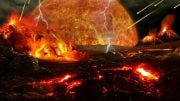
A study from Caltech revealed that the early Earth was formed from hot and dry materials, indicating water’s late arrival during Earth’s formation. This study utilized magmas from different layers of the Earth’s interior, providing unique insights into the planet’s formation.
A new study from Caltech suggests the early Earth formed from hot, dry materials, implying water arrived late in Earth’s formation. The research, offering clues from different mantle layers, posits major additions of volatiles only happened during Earth’s final formation stages, impacting theories of terrestrial planet formation.
Billions of years ago, in the giant disk of dust, gas, and rocky material that orbited our young sun, larger and larger bodies coalesced to eventually give rise to the planets, moons, and asteroids we see today. Scientists are still trying to understand the processes by which planets, including our home planet, were formed.
One way researchers can study how Earth formed is to examine the magmas that flow up from deep within the planet’s interior. The chemical signatures from these samples contain a record of the timing and the nature of the materials that came together to form Earth—analogous to how fossils give us clues about Earth’s biological past.
Now, a study from Caltech shows that the early Earth accreted from hot and dry materials, indicating that our planet’s water—the crucial component for the evolution of life—must have arrived late in the history of Earth’s formation.
The study, involving an international team of researchers, was conducted in the laboratories of Francois Tissot, assistant professor of geochemistry and Heritage Medical Research Institute Investigator; and Yigang Zhang of the University of Chinese Academy of Sciences. A paper describing the research was recently published in the journal Science Advances. Caltech graduate student Weiyi Liu is the paper’s first author.
Though humans do not have a way to journey into the interior of our planet, the rocks deep within the earth can naturally make their way to the surface in the form of lavas. The parental magmas of these lavas can originate from different depths within Earth, such as the upper mantle, which begins around 15 kilometers (9 miles) under the surface and extends for about 680 kilometers; or the lower mantle, which spans from a depth of 680 kilometers (425 miles) all the way to the core–mantle boundary at about 2,900 kilometers (1,800 miles) below our feet.
Like sampling different layers of a cake—the frosting, the filling, the sponge—scientists can study magmas originating from different depths to understand the different “flavors” of Earth’s layers: the chemicals found within and their ratios with respect to one another.
Because the formation of Earth was not instantaneous and instead involved materials accreting over time, samples from the lower mantle and upper mantle give different clues to what was happening over time during Earth’s accretion. In the new study, the team found that the early Earth was primarily composed of dry, rocky materials: chemical signatures from deep within the planet showed a lack of so-called volatiles, which are easily evaporated materials like water and iodine.
In contrast, samples of the upper mantle revealed a higher proportion of volatiles, three times those found in the lower mantle. Based on these chemical ratios, Liu created a model that showed Earth formed from hot, dry, rocky materials, and that a major addition of life-essential volatiles, including water, only occurred during the last 15 percent (or less) of Earth’s formation.
The study is a crucial contribution to theories of planet formation, a field that has undergone several paradigm shifts in recent decades and is still characterized by vigorous scientific debate. In this context, the new study makes important predictions for the nature of the building blocks of other terrestrial planets—Mercury and Venus—which would be expected to have formed from similarly dry materials.
“Space exploration to the outer planets is really important because a water world is probably the best place to look for extraterrestrial life,” Tissot says. “But the inner solar system shouldn’t be forgotten. There hasn’t been a mission that’s touched Venus’s surface for nearly 40 years, and there has never been a mission to the surface of Mercury. We need to be able to study those worlds to better understand how terrestrial planets such as Earth formed.”
Reference: “I/Pu reveals Earth mainly accreted from volatile-poor differentiated planetesimals” by Weiyi Liu, Yigang Zhang, François. L. H. Tissot, Guillaume Avice, Zhilin Ye and Qing-Zhu Yin, 5 July 2023, Science Advances.
DOI: 10.1126/sciadv.adg9213
In addition to Liu and Tissot, co-authors are Zhang of the University of Chinese Academy of Sciences; Guillaume Avice of the Université Paris Cité, Institut de physique du globe de Paris; Zhilin Ye of the Chinese Academy of Sciences; and Qing-Zhu Yin of the University of California, Davis. Funding was provided by the Chinese Academy of Sciences, the National Science Foundation, a Packard Fellowship for Science and Engineering, the Heritage Medical Research Institute, and Caltech.









“Earth formed from hot, dry, rocky materials…” When was it thought otherwise? Outer space is cold and most rocky meteorites are not “wet”, although some contain organic carbon and a few clay minerals. This theory needs a but more evidence to support it.
It is because the outer system is cold that asteroids have so much water (< 0.2 – 20 %) compared to the bone dry inner planet Earth (~ 0.02 %) ["Asteroidal water", Wikipedia].
There are many models for Earth’s water, but even a 15 % late arrival is two orders of magnitude larger than the estimated 0.5 % late accretion of highly siderophile elements.
If so, the planetesimals weren’t completely dry the whole time.